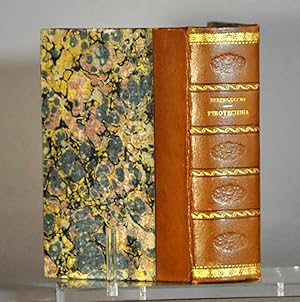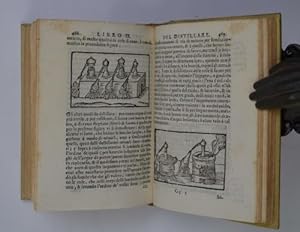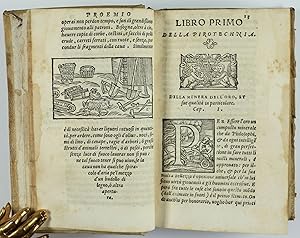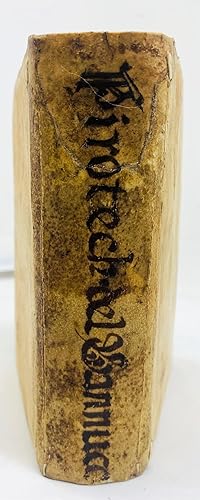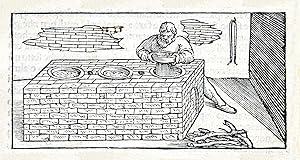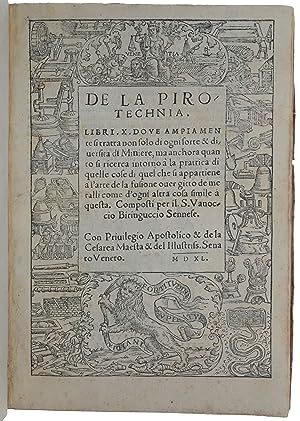BIRINGUCCIO VANNUCCIO (12 Ergebnisse)
Produktart
- Alle Produktarten
- Bücher (12)
- Magazine & Zeitschriften
- Comics
- Noten
- Kunst, Grafik & Poster
- Fotografien
- Karten
-
Manuskripte &
Papierantiquitäten
Zustand
- Alle
- Neu
- Antiquarisch/Gebraucht
Einband
- alle Einbände
- Hardcover (5)
- Softcover
Weitere Eigenschaften
- Erstausgabe (2)
- Signiert
- Schutzumschlag
- Angebotsfoto (7)
- Kein Print-on-Demand
Gratisversand
Land des Verkäufers
Verkäuferbewertung
-
Pirotechnia del Signor Vannuccio Biringuccio, senese, Nella quale fi tratta non folo della diuersita delle Minere, ma anco di quanto si ricerca alla pratica di esse, e che s'appartiene all'arte della susione, o getto de Metalli. (.)
Verlag: In Bologna, per Giosesso Longhi, 1678., 1678
Anbieter: L'Oeil de Mercure, Paris, Frankreich
Couverture rigide. Zustand: Bon. (15), 630 p. Petit in-8, demi-basane brune, dos plat orné, reliure moderne. illustré de nombreuses gravures sur bois dans le texte. Bonne édition de ce célèbre traité de métallurgie dédié à Giuseppe Montecuccoli (ed. originale : 1540).Premier et important traité sur l'art métallurgique, par Vannuccio Biringuccio (1480-1539). Illustré de nombreuses gravures sur bois à mi ou tiers de page représentant tous les instruments nécessaires à la forge et au travail des métaux. Certaines figures, plus techniques, reproduisent les différentes sortes de moules métallurgiques, des cornues et divers ustensiles à l'usage de distillation. La dernière section montre les gestes du travail du fer et quelques objets en fer forgé. Livre ancien.
-
Pirotechnia. Nella quale si tratta non solo della diversità delle Minere, ma anco di quanto si ricerca alla pratica di esse, e che s'appartiene all'arte della fusione, o getto de Metalli. Nuovamente corretta, e ristampata, con le Figure appropriate à suoi luoghi, e due Tavole l'una de Capitoli, e l'altra delle cose Notabili. Dedicata/ All'Illustriss. & Eccellentiss. Sig. e Padron Colendiss. Il Signor Marchese Giuseppe Montecuccoli.
Verlag: In Bologna, per Gioseffo Longhi, 1678. Con Lic. de Sup., Bologna, 1678
Anbieter: Libreria Antiquaria Gonnelli, Firenze, FI, Italien
Zustand: Buono (Good). 0. In-8° (mm 145x100), Carte [16], Pagine 630, [2] bianche. Con oltre 100 xilografie nel testo raffiguranti strumenti, fornaci, stampi, fasi della lavorazione di metalli e oggetti da fusione (campane, armi, alambicchi, attrezzi vari, ecc.). Stemma e timbro di appartenenza al frontespizio, capilettera figurati. Legatura in piena pergamena coeva (titolo manoscritto al dorso); restauro al margine del piatto posteriore. Alcuni forellini di tarlo marginali alle pagine iniziali da 20 a 50, che non toccano il testo. Alcune lievi gore d'acqua lavabili ed qualche arrossatura sparsa, ma buon esemplare. Opera interessante e non comune. Tratta principalmente di metallurgia e chimica. Alcuni capitoli sono dedicati all'alchimia. Graesse I, 431. Gamba, 1261. La data di composizione dell'opera è da collocarsi presumibilmente negli anni 1534-'35. L'opera apparve postuma. La prima edizione venne data alle stampe da Venturino Roffinello (socio del Padovano), nel 1540. Le successive edizioni (1550; 1558) appartengono a Curzio Navo, libraio e tipografo veneto (figlio di Troiano e fratello di Fabio e Scipione). Fu lo stesso Navo che dedicò l'opera a Bernardino di Moncelesi da Salò, a nome del quale sarebbe stata composta l'opera. Le prime edizioni della Pirotechnia (1540; 1550), sono tra le più rare, sebbene vi siano state numerose ristampe successive. Biringuccio V. (Siena 1480-Roma 1537), chimico, mineralogista e metallurgista, professò la matematica e si occupò della fusione dei metalli e della polvere da sparo. Fu al servizio di molti nobili, tra cui Pier Luigi Farnese e il Gran Duca di Toscana. Book.
-
Pirotechnia. Nella quale si tratta non solo delle diversità delle Miniere, ma anco di quanto si ricerca alla pratica di esse, e che s'appartiene all'arte della fusione, ò getto de Metalli. Far Campane, Artigliarie, fuochi artificiali et altre diverse cose utilissime. Nuovamente corretta, e ristampata.
Verlag: Longhi, (1678), In Bologna,, 1678
Anbieter: Studio Bibliografico Benacense, Riva del garda, Italien
Cm. 14,7, pp. (32) 630. Con 84 affascinanti incisioni xilografiche ad un terzo di pagina. Solida ed elegante legatura ottocentesca in piena pergamena rigida, dorso liscio con ricchi fregi in oro e titoli su tassello in marocchino rosso. Qualche leggera brunitura sparsa, ma esemplare genuino ed in ottimo stato di conservazione. Pregevole edizione seicentesca di una delle più interessanti opere scientifiche del Rinascimento. L'originale si impresse nel 1540. La parte iconografica raffigura fornaci, con tutti gli strumenti in uso al tempo, varie fasi della fusione dei metalli, alambicchi, campane, armi e fuochi d'artificio. Cfr. Duween (79): "Famous book on metallurgy and mining, containing interesting chapters on alchemy."; Mieli: "Il trattato del Biringuccio si può qualificare come la prima opera organica relativa a tutto un gruppo di scienze applicate che sia stata pubblicata nel Rinascimento".
-
Pirotechnia Del S. Vannuccio Biringuccio Senese; Nella Quale Si Tratta Non Solo Della Diversita Delle Minere, Ma Ancho Di Quanto Si Ricerca Alla Pratica Di Esse. E Di Quanto S'appartiene All'arte Della Fusione, o Getto, De metalli. Far Campane Arteglierie
Verlag: Appresso P. Gironimo Giglio, e Compagni, In Venetia, 1559
Anbieter: Histoire et Société, Bordeaux, Frankreich
Petit in-8, demi-vélin, plats cartonnés, titre manuscrit au dos, mention manuscrite "Pirotechnia" à l'encre noire sur la tranche inférieure, [1 bl.]-345 ff.-[7 ff.]- [3 ff. bl.], marque de l'imprimeur sur la page de titre, caractères italiques, lettrines, 83 gravures sur bois in-texte, "tavola delle cose notabili" in fine. Dédicace à "Messer Bernardino Moncellese da Salo". Quatrième édition de ce traité fondateur qui fut le premier livre traitant de toute la métallurgie, "étape fondamentale de la littérature technologique". Après trois premières éditions in-quarto (1540, 1550, 1558), notre édition en petit in-8, en constitue en quelque sorte une édition de poche. " L'ouvrage, composé de dix chapitres, aborde toutes les métallurgies, de la fabrication du petit caractère d'imprimerie en plomb (dont Vannoccio Biringuccio -1480-1537- est le premier à définir la délicate méthode de fabrication), aux coulées monumentales de bronze, toutes aussi délicates, des cloches et des canons. Les autres arts du feu ne sont pas en reste puisque sont abordés aussi la chimie, la verrerie, la production de la céramique et même des feux d'artifice. Tous les métaux alors connus sont évoqués depuis la mine d'où ils sont issus et la préparation de ces matières premières, à l'objet semi-fini, toutes les étapes de la chaîne opératoire sont présentées". (in Archéosciences, 34, 2010, 115-119, le plomb chez Vannuccio Biringuccio, de la Pirotechnia, 1540, Patrick Clerc). Cockle, 931. Ex-libris manuscrit "di Aless. (?) Padoani" sur la page de titre (s'agit-il du médecin italien Alessandro Padoanis qui avait constitué une importante bibliothèque scientifique au début du XVIIe ??). Plats et coins de la couverture usagés, rousseurs sur la page de titre, petite restauration ancienne ne touchant pas le texte dans le coin droit des dix premiers feuillets, y compris la page de titre, puis du feuillet 22 à 41, petite trace de vers en coin droit du feuillet 42 à 59, sans aucune conséquence pour le texte, quelques rousseurs éparses, rature à l'encre noire en haut de la première garde blanche, liste manuscrite de nombres au dos de la page de titre. Rare.(ALB5) PHOTOS NUMERIQUES DISPONIBLES PAR EMAIL SUR SIMPLE DEMANDE-DIGITAL PHOTOGRAPS MAY BE AVAILABLE ON REQUEST Size: 11 x 16. Livre.
-
Pirotechnia? Nella quale si tratta non solo della diversità delle minere, ma ancho di quanto; si ricerca alla pratica di esse. E di quanto s?appartiene all?arte della fusione, ò getto, de metalli. Far campane, arteglierie, fuochi artificiati, & altre diverse cose utilissime. Nuovamente corretta, et ristampata.
Verlag: In Venetia: Appresso P. Gironimo Giglio, e compagni. 1559., 1559
Anbieter: Nigel Phillips ABA ILAB, Chilbolton, Vereinigtes Königreich
Small 8vo, ff. 345, (7). Woodcut device on title, historiated woodcut initials, numerous pictorial woodcuts in the text, text printed in italics. Title-page shaved at top touching letters of first word, some foxing, dampstain in fore-edge margin of first and last leaves. Contemporary vellum, spine lettered in gilt, upper cover a little stained, a few small holes in the vellum. Early inscription erased from title leaving two tiny holes. Bookplate of Clifton College Science Library. Fourth edition of the only printed work to cover the whole field of metallurgy as known at that time, and the first comprehensive account of the fire-using arts. This work is the fruit of Biringuccio?s actual experience, and embraces virtually the whole field of technology. It is divided into ten books, which deal with (1) metallic ores; (2) the ?semi-minerals? (including mercury, sulphur, gems and glass); (3) assaying and preparing ores for smelting; (4) the parting of gold and silver, both with nitric acid, and with antimony sulfide or sulphur; (5) alloys of gold, silver, copper, lead, and tin; (6) the art of casting large statues and guns; (7) furnaces and methods of melting metals; (8) the making of small castings; (9) miscellaneous pyrotechnical operations, including alchemy, distillation, smithing and pottery; and (10) the making of saltpetre, gunpowder and fireworks. ?Virtually all of Biringuccio?s descriptions are original. He is important in art history for his description of the peculiarly Renaissance arts of casting medallions, statues, statuettes, and bells. His account of typecasting, given in considerable detail, is the earliest known. The Pirotechnia contains eighty-three woodcuts, the most useful being those depicting furnaces for distillation, bellows mechanisms, and devices for boring cannon and drawing wire. ?[It] is a prime source on many practical aspects of inorganic chemistry. Biringuccio?s approach is in strong conflict with that of the alchemists, whose work he evaluates in eleven pages of almost modern criticism, distinguishing their practical achievements from their theoretical motivations. Duveen pp. 79?80. See Dibner 38; Parkinson, Breakthroughs, 1540; Stillwell, The awakening interest in science, VI, 827. Partington, II, pp. 32?37. Singer, History of technology, III, p. 27, etc.
-
Pirotechnia.nella quale si tratta non solo della diversità delle minere, ma ancho di quanto; si ricerca alla pratica di esse. E di quanto s'appartiene all'arte della fusione, ò getto, de metalli. Far campane, arteglierie, fuochi artificiati, & altre diverse cose utilissime. Nuovamente corretta, et ristampata
Anbieter: Jonathan A. Hill, Bookseller Inc., New York, NY, USA
Erstausgabe
Woodcut device on title & numerous woodcuts in the text. 345, [7] leaves. Small 8vo, cont. vellum (some foxing, dampstain in fore-edge margin of first & last leaves). Venice: P.G. Giglio, 1559. Fourth edition of the first systematic book on mining and metallurgy. Biringuccio (1480-1539?), after travelling throughout Italy and Germany inspecting metallurgical operations and running an iron mine and forge at Boccheggiano, was appointed director of the mint at Siena. He later cast cannon and built fortifications for the Este and Farnese families. At the time of his death he was head of the papal foundry and director of papal munitions at Rome. This work embraces the whole field of technology. It "was written for the practicing metallurgist, foundryman, dyer, type-founder, glass-maker, and maker of gunpowder, fireworks and chemicals used in warfare."-Dibner, Heralds of Science, 38-(1st ed. of 1540). "Virtually all of Biringuccio's descriptions are original. He is important in art history for his description of the peculiarly Renaissance arts of casting medallions, statues, statuettes, and bells. His account of typecasting, given in considerable detail, is the earliest known. The Pirotechnia contains eighty-three woodcuts, the most useful being those depicting furnaces for distillation, bellows mechanisms, and devices for boring cannon and drawing wire. "The Pirotechnia is a prime source on many practical aspects of inorganic chemistry. Biringuccio emphasizes the adaptation of minerals and metals to use - their alloying, working, and especially the art of casting, of which he writes in great detail. In this area he is far better than the two other sixteenth-century authors with whom he is inevitably compared, Georgius Agricola and Lazarus Ercker. "Biringuccio's approach is in strong conflict with that of the alchemists, whose work he evaluates in eleven pages of almost modern criticism, distinguishing their practical achievements from their theoretical motivations. "Biringuccio has been called one of the principal exponents of the experimental method."-D.S.B., II, p. 143. A very good copy. Upper cover of binding a little stained and with a few small holes in the vellum. Early inscription erased from title leaving two tiny holes. Bookplate of Clifton College Science Library. â § Brunet, I, 954. Duveen, p. 80. Partington, II, pp. 32-37. Singer, History of Technology, III, p. 27 & passim. Wolf, History of Science, I, p. 486.
-
Pirotechnia nella quale si tratta non solo della diversità delle minere, ma ancho di quanto si ricerca alla pratica di esse.
Verlag: E di quanto s'appartiene all'arte della fusione, o getto, de metalli. Far campane, arteglierie, fuochi artificiali.Nuovamente corretta, et ristampata. Venetia, Gir. Giglio, 1558 (in fine 1559),, Venezia, 1559
Anbieter: Libreria Antiquaria Pregliasco, Torino, Italien
Zustand: molto buono. in-8 gr., ff. 345, (7), leg. coeva p. perg. Marca tip. sul tit., car. corsivo, iniz. silogr. Proemio dedicato dall'a. a Bernardino Moncellese da Salò. Nel testo 84 figure silogr. di grande interesse riproducenti strumenti e fasi della fusione dei metalli, fornaci, alambicchi, campane, armi, ecc. Pregevolissima terza edizione (la prima apparve nel 1540) della più attraente opera di tecnologia pratica del XVI secolo, la prima e più celebre sulla metallurgia e mineralogia, la lavorazione a fuoco, con riferimenti anche all'alchimia. Biringuccio (nato a Siena nel 1480 e morto a Roma nel 1537), grande amico di Ben. Varchi, si occupò della costruzione di fornaci e mantici, della direzione di miniere e della fabbricazione di artiglierie in varie parti d'Italia. (Esemplare con qualche arrossatura e non grande di margini). STC 106. Hoover Coll. 129 (I ed.): «.one of the classics in the history of science and technology». Duveen 79: «famous book on metallurgy and mining, containing interesting chapters on alchemy and illustrated by very fine woodcuts». Mieli, Scienziati ital. I, pp. 20-24: «Il trattato di Biringuccio si può qualificare come la prima opera organica relativa a tutto un gruppo di scienze applicate che sia stata pubblicata nel Rinascimento». Per ulteriori notizie bio-bibliogr. cfr. Diz. Biogr. Ital. X, 625-631. Govi, Classici, 72 (ed. 1540). Book.
-
Pirotechnia. Li diece libri della Pirotechnia, nelli quali si tratta non solo la diversita delle miniere, ma ancho quanto si ricerca alla prattica di esse: e di quanto s'appartiene all'arte della fusione over getto de metalli, d'ogni altra cosa a questa somigliante.
Verlag: Venice, G. Padovano for Curtio di Navò,, 1550
Anbieter: Mayfair Rare Books & Manuscripts Ltd, London, Vereinigtes Königreich
Buch
Hardcover. Zustand: Good. 4to (210 x 145 mm), early 19th cent. vellum recased, title in gold on brown calf label at spine, pastedowns in coloured paper, a good copy. Title within full-page illustrated woodcut border, ff. (8), 167 (1, with printer s woodcut device at verso), finely illustrated with 84 half-page woodcuts in the text. Second edition of the only printed work to cover the whole field of metallurgy as known at that time, and Biringuccio s only published book. It was "written for the practicing metallurgist, foundryman, dyer, type-founder, glass-maker, and maker of gunpowder, fireworks and chemicals used in warfare. The second chapter is devoted to alum. Here is first mentioned cobalt blue and manganese and the use of sodium chloride for separating gold and silver from baser metals" (Dibner). Biringuccio here gives the earliest account of typecasting and the making of statues, medallions, and bells. "Agricola freely borrowed several sections of the Pirotechnia for use in his later work" (Hoover). "Virtually all of Biringuccio s descriptions are original. He is important in art history for his description of the peculiarly Renaissance arts of casting medallions, statues, statuettes, and bells. His account of typecasting, given in considerable detail, is the earliest known. The Pirotechnia contains eighty-three woodcuts, the most useful being those depicting furnaces for distillation, bellows mechanisms, and devices for boring cannon and drawing wire.[It] is a prime source on many practical aspects of inorganic chemistry. Biringuccio s approach is in strong conflict with that of the alchemists, whose work he evaluates in eleven pages of almost modern criticism, distinguishing their practical achievements from their theoretical motivations. Biringuccio has been called one of the principal exponents of the experimental method." (DSB). Hoover cat. 130; Duveen p. 79; Parkinson, Breakthroughs, 1540; Stillwell, The awakening interest in science, VI, 827; Partington, II, pp. 32 37. Singer, History of technology, III, p. 27, etc. Cockle, Military books, 931.
-
Pirotechnia. Li diece libri della pirotechnia. Nelli quali si tratta non solo della diversit? delle minere, ma ancho quanto si ricerca alla pratica di esse: e di quanto síappartiene allíarte della fusione, over getto de metalli e díogni altra cosa.
Verlag: per Giovan Padoano, a instantia di Curtio di NavÚ, Venezia, 1550
Anbieter: libreria antiquaria perini Sas di Perini, Verona, VR, Italien
In 8?(211x155); carte non num. 8, numerate 167, una non numerata che riporta la marca editoriale in silografia; ottantaquattro silografie nel testo ad un terzo di pagina raffiguranti strumenti e metodi per la lavorazione dei metalli, per la produzione di vetri, campane per la distillazione ed altro; frontespizio incorniciato da ricca bordura silografica con il trionfo di Venezia in alto ed il leone di San Marco in basso attorniati da alambicchi, campane, fornaci ed altri strumenti vari, capilettera entro vignette silografiche. Legatura in pergamena rigida posteriore rimontata, titolo manoscritto su etichetta cartacea, filetti rossi al dorso. Seconda edizione, tipograficamente superiore alla prima del 1540, concordemente al parere di Smith & Gnudi, traduttori dellíedizione inglese (1942). Riporta dedica al verso del frontespizio a Guidotto Napio boemo; nel proemio dedica al M. Bernardino Moncellese da SalÚ. Questo celebre trattato sulla tecnica della lavorazione a fuoco si compone di dieci libri suddivisi in capitoli: descrive i metalli, la metodologia per formare le leghe e per la lavorazione dei metalli stessi, tratta della calamita e sue propriet?, delle miniere, delle fornaci, dellíartiglieria, della distillazione, della fusione, delle campane ed anche dei fuochi artificiali; fu pubblicato postumo nel 1540, tre anni dopo la morte del Biringuccio e riscosse immediatamente successo, dimostrato dalle numerose edizioni di met? Cinquecento. Biringuccio (Siena 1480 - Roma 1537), chimico, mineralogista e metallurgista, professÚ la matematica e si occupÚ della fusione dei metalli e della polvere da sparo. Fu al servizio di molti nobili, tra cui Pier Luigi Farnese e il Gran Duca di Toscana. Bellíesemplare genuino. Antica nota di possesso manoscritta al frontespizio sul margine inf. rimarginato per una probabile precedente eliminazione di altra nota di propriet?; nota cassata al margine est. della seconda carta n.n. Lievi saltuarie tracce díuso al margine di alcune carte. Mieli, ìScienziati italianiî, I, pp. 20-24: Il trattato di Biringuccio si puÚ qualificare come la prima opera organica relativa a tutto un gruppo di scienze applicate che sia stata pubblicata nel Rinascimentoªª. Duveen 79: î Famous book on metallurgy and mining, containing interesting chapters on alchemy and illustrated by very fine woodcutsî. Adams, B-2083; Honeyman Coll. 336; Hoover Coll. 131; Mortimer, Italian 66 (Anm.); Wellcome I, 874. Duveen p. 79. Dibner 38; Parkinson, Breakthroughs, 1540.
-
Pirotechnia
Verlag: C. Maesta, Venice, 1550
Anbieter: B & L Rootenberg Rare Books, ABAA, Sherman Oaks, CA, USA
SECOND EDITION. Title within woodcut border with elaborate woodcut illustrations of various machines and apparatus, numerous text woodcuts as well as elaborate woodcut initials. Eighteenth century vellum backed marbled boards, edges and corners worn; first 8 leaves repaired at upper right corner, some browning, contemporary annotations throughout. Contemporary ownership signature of Giovanni Giulio Bruschi on title (he signs Brusco on the final leaf above the colophon), another signature, Alfonso Ruso (?) with an additional notation partially cut off at the bottom of the title page, and an annotation in pencil of Henry Blumenberg Jr. Dated July 1, 1925, Los Angeles, Cal., on the fly-leaf. Second edition. This was the first printed book dealing with metallurgy. It was "written for the practicing metallurgist, foundryman, dyer, type-founder, glass-maker, and maker of gunpowder, fireworks and chemicals used in warfare. The second chapter is devoted to alum. Here is first mentioned cobalt blue and manganese and the use of sodium chloride for separating gold and silver from baser metals" (Dibner). Biringuccio here gives the earliest account of typecasting and the making of statues, medallions, and bells. "Agricola freely borrowed several sections of the Pirotechnia for use in his later work" (Hoover). All of Biringuccio's descriptions are original, and his intention with the book was definitely descriptive. He viewed alchemy as "nontechnical and noncodifiable" by its practitioners. The woodcuts depict furnaces for distillation, bellows mechanisms, and devices for boring cannon and drawing wire. "The Pirotechnia is a prime source on many practical aspects of inorganic chemistry. Biringuccio emphasizes the adaptation of minerals and metals to use - their alloying, working, and especially the art of casting, of which he writes in great detail. In this area he is far better than the two other sixteenth-century authors with whom he is inevitably compared, Georgius Argicola and Lazarus Ercker." According to Smith & Gnudi, the translators of the English edition (1942), this second edition is typographically superior to the first edition of 1540. Biringuccio (1480-1539?), after travelling throughout Italy and Germany, inspecting metallurgical operations and running an iron mine and forge at Boccheggiano, was appointed director of the mint at Siena. He later cast cannon and built fortifications for the Este and Farnese families. At the time of his death he was head of the papal foundry and director of papal munitions at Rome.
-
Pirotechnia. Li diece libri della Pirotechnia, nelliquali si tratta non solo la diversita delle minere, ma ancho quanto si ricerca alla prattica di esse: e di quanto s?appartiene all?arte della fusione over getto de metalli, d?ogni altra cosa a questa somigliante.
Verlag: [Colophon:] In Vinegia [Venice]: per Giovan Padoana, a instantia di Curtio di Navo, 1550., 1550
Anbieter: Nigel Phillips ABA ILAB, Chilbolton, Vereinigtes Königreich
4to, ff. (viii), 167, (1). Title within ornate woodcut border depicting working apparatus, printer?s handsome woodcut device on recto of last leaf, numerous pictorial woodcuts in the text. Small stain in lower inner corners only occasionally encroaching on the text, otherwise a very clean copy. Eighteenth century marbled boards (ends of spine slightly rubbed), red lettering label and paper shelf label on spine. Second edition of the only printed work to cover the whole field of metallurgy as known at that time, and the first comprehensive account of the fire-using arts. This work is the fruit of Biringuccio?s actual experience, and embraces virtually the whole field of technology. It is divided into ten books, which deal with (1) metallic ores; (2) the ?semi-minerals? (including mercury, sulphur, gems and glass); (3) assaying and preparing ores for smelting; (4) the parting of gold and silver, both with nitric acid, and with antimony sulfide or sulphur; (5) alloys of gold, silver, copper, lead, and tin; (6) the art of casting large statues and guns; (7) furnaces and methods of melting metals; (8) the making of small castings; (9) miscellaneous pyrotechnical operations, including alchemy, distillation, smithing and pottery; and (10) the making of saltpetre, gunpowder and fireworks. ?Virtually all of Biringuccio?s descriptions are original. He is important in art history for his description of the peculiarly Renaissance arts of casting medallions, statues, statuettes, and bells. His account of typecasting, given in considerable detail, is the earliest known. The Pirotechnia contains eighty-three woodcuts, the most useful being those depicting furnaces for distillation, bellows mechanisms, and devices for boring cannon and drawing wire. ?[It] is a prime source on many practical aspects of inorganic chemistry. Biringuccio?s approach is in strong conflict with that of the alchemists, whose work he evaluates in eleven pages of almost modern criticism, distinguishing their practical achievements from their theoretical motivations. ?Biringuccio has been called one of the principal exponents of the experimental method.? (DSB). This is Biringuccio?s only published book and the sole source for his work. This second edition is typographically superior to the first edition of 1540 according to Smith & Gnudi, the translators of the English edition (1942). Hoover catalogue 130. Duveen p. 79. See Dibner 38; Parkinson, Breakthroughs, 1540; Stillwell, The awakening interest in science, VI, 827. Partington, II, pp. 32?37. Singer, History of technology, III, p. 27, etc. Cockle, Military books, 931.
-
De la pirotechnia. Libri X. Dove ampiamente si tratta non solo di ogni sorte & diversita di miniere, ma anchora quanta si ricerca intorno a la prattica di quelle cose di quel si appartiene a l'arte de la fusione over gitto di metalli come dogni altra cosa simile a questa
Verlag: Venturino Ruffinello for Curtio Navo and brothers, [Colophon:] Venice, 1540
Erstausgabe
First edition. DIBNER 38: THE FIRST COMPREHENSIVE TREATISE ON THE PYROTECHNIC ARTS. First edition, very rare in contemporary binding, of the "first comprehensive treatise on the 'pyrotechnic' or fire-using arts, including mining, metallurgy, applied chemistry, gunpowder, military arts and fireworks. Virtually all of Biringuccio's descriptions are original, based upon first-hand information garnered during his various employments as a mine and forge operator, director of the Sienese mint, cannon caster and fortification builder, director of building construction at the Duomo, and head of the papal foundry and munitions works. His account of the adaptation of metals to use by alloying, working and casting excels those of Ercker and Agricola, and his sections on glass, steel and the purification of salts by crystallization were copied almost verbatim in Agricola's De re metallica (1556). Biringuccio's work is important to art history for its description of the Renaissance methods of casting medallions, statues and bells; and to the history of printing for containing the earliest known account of typecasting. His contributions to chemistry include the first account of silver amalgamation and liquation, the earliest mention of cobalt blue and manganese, and the first description of antimony, antedating that of Basil Valentine by fifty years" (Norman catalogue). It "was written for the practicing metallurgist, foundryman, dyer, type-founder, glass-maker, and maker of gunpowder, fireworks and chemicals used in warfare" (Dibner).The woodcuts show the use of various furnaces, pulleys and tools, and illustrate the making of bells, pottery and firearms. Biringuccio was "one of the principal exponents of the experimental method" (DSB II, 143). He entered the service of the ruler of Siena, Pandolfo Petrucci, undertook a period of travel in Germany, then the metallurgical capital of Europe, was involved in such politically useful activities as the manufacture of guns, gunpowder, and counterfeit money. He later served the Dukes of Parma, Ferrara, and the Venetian Republic. ABPC/RBH list only two copies in contemporary binding since the Kenney sale in 1966. "Biringuccio's reputation derives from a single work, his Pirotechnia, published posthumously in 1540. The work is divided into ten books, which deal with (1) metallic ores; (2) the 'semiminerals' (including mercury, sulfur, alum, arsenic, vitriol, several pigments, gems, and glass); (3) assaying and preparing ores for smelting; (4) the parting of gold and silver, both with nitric acid and with antimony sulfide or sulfur; (5) alloys of gold, silver, copper, lead, and tin; (6) the art of casting large statues and guns; (7) furnaces and methods of melting metals; (8) the making of small castings; (9) miscellaneous pyrotechnical operations (including alchemy; the distillation of acids, alcohol, and other substances; the working of a mint 'both honestly and with profit' the goldsmith, silversmith, and ironsmith; the pewterer; wire-drawing; mirror-making; pottery; and bricks); and (10) the making of saltpeter, gunpowder, and fireworks for warfare and celebration . The Pirotechnia contains eighty-three woodcuts, the most useful being those depicting furnaces for distillation, bellows mechanisms, and devices for boring cannon and drawing wire. "As the first comprehensive account of the fire-using arts to be printed, the Pirotechnia is a prime source on many practical aspects of inorganic chemistry. Biringuccio emphasizes the adaptation of minerals and metals to use - their alloying, working, and especially the art of casting, of which he writes in great detail. In this area he is far better than the two other sixteenth-century authors with whom he is inevitably compared, Georgius Agricola and Lazarus Ercker. Although Agricola excels on mining and smelting, his famed sections on glass, steel, and the purification of salts by crystallization are in fact taken nearly verbatim from the Pirotechnia. "Biringuccio's approach is in strong conflict with that of the alchemists, whose work he evaluates in eleven pages of almost modern criticism, distinguishing their practical achievements from their theoretical motivations. His interest in theoretical questions is limited to the repetition of an essentially Aristotelian view of the origins of metallic ores and the nature of metals, with a rather forced extension to account for the observed increase in weight of lead when it is turned to litharge [lead monoxide]. "Biringuccio has been called one of the principal exponents of the experimental method, for he states that 'It is necessary to find the true method by doing it again and again, continually varying the procedure and then stopping at the best' and 'I have no knowledge other than what I have seen with my own eyes.' He gives quantitative information wherever appropriate. He was certain that the failure of an operation was due to ignorance or carelessness, not to either ill luck or occult influences: Fortune could be made to favor the foundryman by paying careful attention to details. Biringuccio's method, however, is not that of the scientist, for none of his operations is planned to test theory or even reflects the conscious application of it. He represents the strain of practical chemistry that had to develop and to be merged with philosophy before it could become science. Yet the enjoyment of the diverse properties of matter and the careful recording of a large number of substances and types of reactions that had been established by various craftsmen were just as necessary as the works of the philosophers, and in some sense were nearer the truth" (DSB). "First and foremost [Biringuccio] stands out as the practical man, concerned with carrying out operations on metals for profit and for use. He realizes the advantages of large-scale operation and advises the use of power-driven machinery in place of hand labor whenever possible. The availability of adequate water-power is the.


